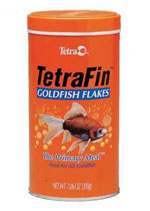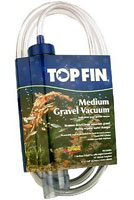MacQuarium Care
Caring for Your MacQuarium (and Fish Too)
Your MacQuarium will take ongoing care to keep your fish happy and healthy. The two main aspects of fish care include feeding and cleaning the tank, which are outlined below. It's not tricky to care for fish, but like any pet, it takes some dedication.
Feeding
Fish, obviously, need to eat. They have the drinking part pretty well taken care of, but you need to feed them daily. Here are the details.
 There are many types of fish food on the market, and, depending on the type of fish you have, you may need to get a special variety. But for most fish, standard flake food should be sufficient. I've been happy with Tetra brand food, but there are many other good brands out there.
There are many types of fish food on the market, and, depending on the type of fish you have, you may need to get a special variety. But for most fish, standard flake food should be sufficient. I've been happy with Tetra brand food, but there are many other good brands out there.
All you need to do is drop a pinch of food in the tank once a day. Don't put too much in, as it'll unnecessarily dirty the water, but put enough in so your fish gets enough to eat. An easy way to tell how much food you need to put in is to drop a pinch into the tank, then estimate how much of it your fish actually eats. If the majority of it ends up settling on the gravel, you can cut back.
Don't change brands or types of food often. Fish like regularity. You will want to turn the tank light on during the day and off at night (to simulate the natural pattern of day and night); putting the light on a timer is a very good idea. (Don't put the air pump on a timer, though; leave it on constantly).
Cleaning the Tank
When the water looks dirty, the sides of the tank are cloudy or have algae growing on them, and the gravel seemingly has stuff growing on it, it's time to clean the tank. You need a couple tools for cleaning the tank properly:
 Gravel vacuum. This works by starting a siphon in the tank and then crunching the business end of the tube in the gravel. Like magic, the junk built up in the gravel gets sucked up with the dirty water, and the gravel stays in the tank. The smallest siphon should do; get too big of a siphon and all the water may drain out of the tank before you have a change to clean all the gravel. You'll want to have a 5-gallon bucket for the water to siphon into.
Gravel vacuum. This works by starting a siphon in the tank and then crunching the business end of the tube in the gravel. Like magic, the junk built up in the gravel gets sucked up with the dirty water, and the gravel stays in the tank. The smallest siphon should do; get too big of a siphon and all the water may drain out of the tank before you have a change to clean all the gravel. You'll want to have a 5-gallon bucket for the water to siphon into.
Fish net and resealable bags. Fish know when it's tank-cleaning time, and they'll try to hide when it comes time to remove them from the tank. If you can catch them in a quart-sized resealable bag (like a Ziploc), do so, make sure sufficient water is in the bag with the fish, and then seal it up and put it in a bowl (to keep it from rolling away). Sometimes you'll need a fish net to catch the fish and put them into the bag. Get both to be safe.
 Tank scrubber. Gunk will accumulate on the inside of the glass, and you'll need something scrubby to clean it off. Don't use a household scouring pad, as it can either scratch the glass or have chemicals in it that can contaminate the water. An aquarium scrubber is on a long handle, for getting into the corners, and will not harm the glass or fish.
Tank scrubber. Gunk will accumulate on the inside of the glass, and you'll need something scrubby to clean it off. Don't use a household scouring pad, as it can either scratch the glass or have chemicals in it that can contaminate the water. An aquarium scrubber is on a long handle, for getting into the corners, and will not harm the glass or fish.
Once you have all of that stuff at the ready, here's the process to follow.
1. Get the fish out of the tank. Either scoop them with the bag, or use the fish net to push them into the bag. Try to keep the fish in the water at all times--you wouldn't like to be held underwater for a long time, so why hold your fish above water for more than necessary? Be sure to get an adequate amount of tank water in with the fish. Seal the bag, and put it in a bowl to keep it from rolling away. For the overly paranoid, put the bag into another sealed bag just in case.
2. Start the siphon. (Try not to drink any of the tank water, it doesn't taste very good.) Put the end of the hose into the 5-gallon bucket, and the tube into the tank. Crunch the tube around in the gravel, covering the entire surface of the bottom of the tank, to suck up accumulated gunk. When you run out of water to continue siphoning, empty the bucket, remove the front bezel of the MacQuarium, and gently slide the tank out. Rinse out the bucket, remove the plants, toys, and filter from the tank, and dump the gravel into the bucket.
3. Take the tank over to a sink and give it a good rinsing. Do not use soap. Scrub down the sides and bottom of the tank with the scrubber, and rinse off the plants and other stuff. Replace the filter, if you have one.
4. Rinse out the gravel. Dump it into a collander or just swish it around in the bucket while running clean water over it.
5. Put the gravel, filter, toys, and plants back into the tank, and slide it back into the MacQuarium shell. Push the bezel back on, and reconnect your air lines.
6. Refill the tank with the water you set aside last time. (Remember, when you first set up the tank, or the last time you cleaned it, you should have set aside about 3 gallons of treated water.) Let the water sit for a minute or two (it should already be room temperature). Fire up the air pump. If you forgot to do this, fill the tank with tap water as close in temperature to room temperature as you can, then add the appropriate amount of aquarium chemicals. Let the tank sit for at least half an hour so the chemicals can disperse and the temperature can settle a little more.
7. Float the bag with the fish in the tank for at least 15 minutes. Even though the two water temperatures should be the same, sometimes they're not. Play it safe and float the bag. Afterwards, just cut the bag open and release the contents, fish and all.
8. Leave the tank light off for a while. The fish can get stressed during this time, so let them chill out before you turn the light back on.
9. Prepare your water for next time. Refill your jugs, treat the water, and set them aside. Keeping water at the ready is also useful for topping off a tank in-between cleanings; as time progresses, the water in the tank will slowly evaporate. If the water level is an inch or more below the top of the tank, pour a little more in. You shouldn't need to put the fish in a bag or anything because you're adding relatively little water.
And that's it! Clean the tank regularly and your fish will thank you.
Copyright 2009 Colin Wirth.
